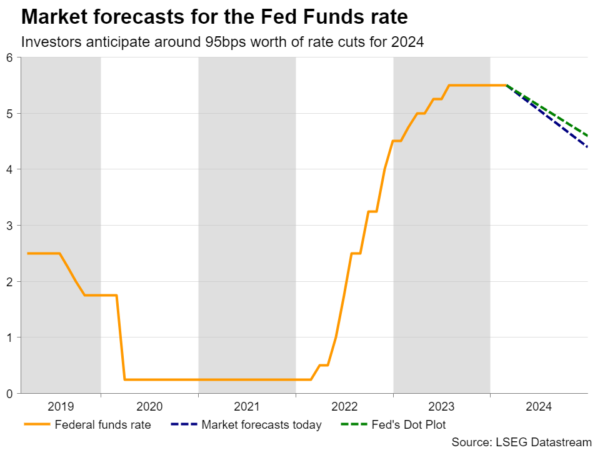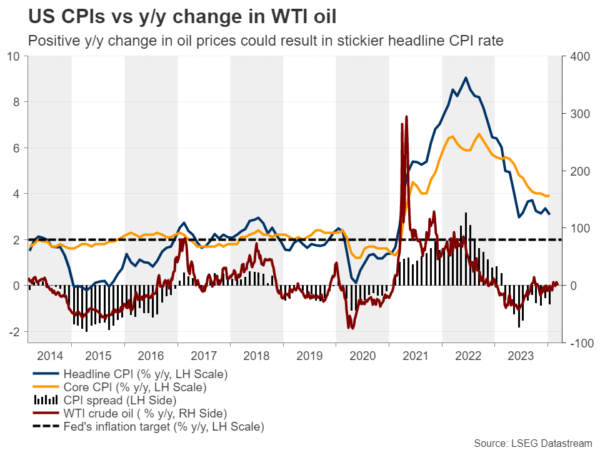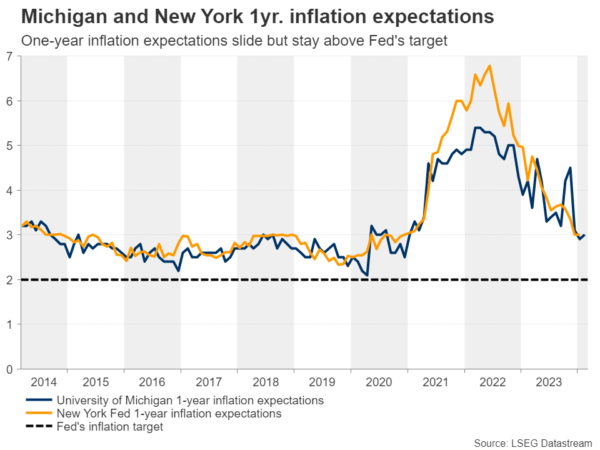- Weak ISM PMIs and dovish Powell hurt the dollar
- Investors add to their June rate cut bets
- US CPI data the next test for the greenback
- The data is scheduled for Tuesday at 12:30 GMT
After Powell’s testimony, investors see June cut a done deal
There has been a notable repricing in market expectations with regards to the Fed’s future course of action since the start of the year. From penciling in around 160bps worth of rate cuts by December, at some point the market got confident that the Fed will reduce interest rates by only 80bps, just five points more than the Fed’s December projections of 75bps. What has led to this repricing was data pointing to a US economy firing on all cylinders, a still-tight labor market, stickier than expected inflation, and a less-dovish-than-expected Fed.
However, after the disappointing ISM PMIs and the Congressional testimony by Fed Chair Powell, investors have added back some basis points worth of cuts, now expecting interest rates to end the year 95bps below current levels.

During his second Congressional testimony, before the Senate Banking Committee, the Fed Chief said that the central bank was “not far” from gaining the confidence it needs to begin cutting interest rates, although he was reluctant to declare the inflation battle had been won. His comments refueled bets that a first quarter-point cut will be delivered in June, with the probability of such an action rising to around 95%.
Will US inflation get closer to the Fed’s 2% objective?
With all that in mind, the spotlight next week is likely to turn to Tuesday’s CPI data for February. The forecasts suggest that the headline rate remained unchanged at 3.1% y/y, while the core one is expected to have slid to 3.7% y/y from 3.9%. According to both the ISM manufacturing and non-manufacturing PMIs, prices continued to increase in February, but at a slower pace than in January, corroborating the forecast for the core CPI rate, while the fact that the year-on-year change in oil prices turned somewhat positive lately, supports the notion for a sticky headline rate.

Therefore, with headline inflation not cooling, the US dollar may initially receive some support, but a further slowdown in underlying price pressures is unlikely to tempt investors to reduce their June cut bets as it may add to Fed officials’ confidence that inflation is moving sustainably towards their objective.
The dollar could soon give back any headline-related gains and resume its recent short-term downtrend, while equities are likely to continue marching north, as expectations of lower interest rates are a positive for present values of high-growth tech firms, which are usually valued by discounting expected free cash flows for the quarters and years ahead.
Is an upward revision in the dot plot possible?
For the dollar to stage a strong comeback, the Fed may need to revise up its dot plot when it meets on March 20. Although Powell sounded more dovish than expected when testifying before Congress, other policymakers have been vocal about their preference of fewer rate cuts than the December dot plot pointed to. Atlanta Fed President Bostic said recently that only two rate cuts may be appropriate by the end of his year, while Minneapolis Fed President Kashkari talked about the possibility of even only one reduction. What’s more, both the University of Michigan and the New York Fed 1-year inflation expectations are both resting at 3.0%, suggesting no material progress in lowering the inflation consumer expect.

Having said all that though, Kashkari is not a voting member this year, and Bostic is the only member who clearly favored less than three cuts, at least until now. So, although an upside revision in the Fed’s interest rate projections is not totally off the cards, especially with the US economy still performing better than its major peers, it currently appears to be a less likely case.
Dollar index completes a failure swing top
From a technical standpoint, the dollar index accelerated its slide in the last couple of days, breaking below the key zone of 103.65 and completing a failure swing top formation. The index is now ready to challenge the 102.65 zone, where a dip could aim for the 102.00 zone. For the outlook to change to bullish, the index may need to climb all the way above the psychological number of 105.00, which was last tested on February 14.










